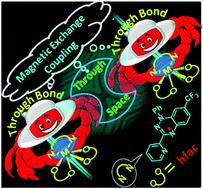Probing through-space and through-bond magnetic exchange couplings in a new benzotriazinyl radical and its metal complexes†
Abstract
The synthesis and characterization of a new chelating benzotriazinyl radical (Rad2) are described. Crystallographic studies coupled with SQUID magnetometry on Rad2 reveal the presence of discrete radical pairs which are antiferromagnetically coupled. The reaction of Rad2 with the 3d transition metal complexes M(hfac)2·xH2O (hfac− = hexafluoroacetylacetonate) led to mononuclear metal complexes of general formula M(hfac)2(Rad2) [M = Zn(II) (1); Ni(II) (2) and Co(II) (3)] whose structures have been determined by single crystal X-ray diffraction. Compounds 1–3 are isostructural and crystallize in the monoclinic space group P21/n with two molecules in the asymmetric unit. In the case of the Zn(II) complex (1) through-space intermolecular radical⋯radical antiferromagnetic exchange interactions via π*⋯π* contacts are observed, whereas strong intramolecular through-bond metal–radical ferromagnetic interactions [J = +59.3(9) cm−1] are observed for the Ni(II) complex (2). For the Co(II) complex (3), computational and magnetic studies reveal substantial zero field splitting and ferromagnetic metal–radical interactions.



 Please wait while we load your content...
Please wait while we load your content...